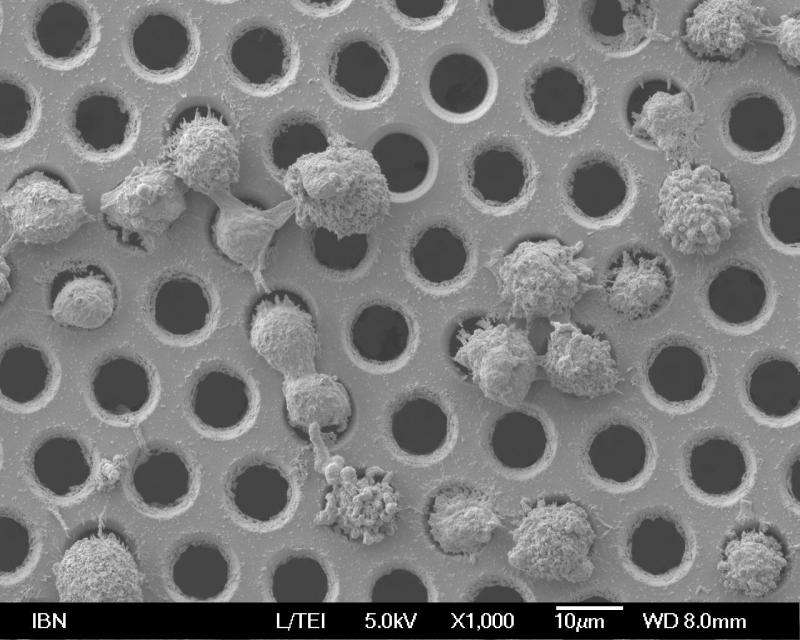A new way of looking at cancer

Clusters of circulating cells commonly found in the blood of cancer patients have long been the subject of research on cancer. These clusters have been regarded for more than 50 years as malignant cells that have broken off from the primary tumor, spreading cancer to other parts of the body. Now, researchers at the Institute of Bioengineering and Nanotechnology (IBN) of A*STAR have reported that these clusters are unlike what others have assumed previously, potentially opening up new ways to detect and inhibit the spread of cancer.
Due to the technical challenges of separating these clusters from normal blood cells, limited research has been performed on these clusters. The working assumption was that these cell clusters are malignant cells from the tumor.
A national research team led by Dr Min-Han Tan, Team Leader and Principal Research Scientist at IBN, has shown that these cell clusters come from the blood vessels that line the tumor rather than from the tumor itself. The team includes researchers from IBN, A*STAR's Genome Institute of Singapore, Concord Cancer Hospital, National University of Singapore, National Cancer Centre Singapore, and Singapore General Hospital.
The researchers set out to comprehensively study these circulating cell clusters at a single cell-scale in 80 colorectal cancer patients. They first separated the cell clusters from the blood samples of the colorectal patients using a custom-designed microdevice developed by Prof Jackie Y. Ying's laboratory at IBN that enables quick and efficient capture and retrieval of the circulating cell clusters. Next, the researchers used high-throughput DNA and RNA sequencing and computational modelling to determine the identity of these cells.
After four years of research, the results confirmed that in colorectal cancer, these circulating cell clusters are endothelial cells from the blood vessels lining the tumor and are non-cancerous. Unexpectedly, the researchers also discovered that more endothelial cell clusters were found in colorectal cancer patients who have not received any treatment, compared to those who have received treatment, suggesting that these cells could be used for early-stage cancer detection.
"The goal of cancer research is to understand how cancer spreads in order to curb the disease. Our institute has been focusing on evaluating cancer in a non-invasive way through blood testing using our novel microfiltration technique. Knowing exactly where these circulating cell clusters come from will lead us towards better approaches of diagnosing and treating cancer," said Professor Jackie Y. Ying, Executive Director, IBN.
The colorectal cancer samples for this study were provided by the Concord Cancer Hospital (previously Fortis Surgical Hospital). IBN has been collaborating with the hospital, in particular Dr Poh Koon Koh, who was former Adjunct Clinician Scientist at IBN, to advance cancer research since setting up a joint tissue bank in 2012 to store and maintain patient samples for research.
"Scientific orthodoxy has maintained for decades that these cell clusters commonly observed in cancer patients were malignant tumor cells. In contrast, we found that these cell clusters are not malignant, but come from the blood vessels lining the tumor that presumably peeled off during blood flow through the tumor. This insight requires a reconsideration of decades of data, and gives scientists new opportunities to investigate and starve the cancer through drugs that manipulate the blood vessels of tumors. This method also gives physicians a new understanding and method of monitoring tumor blood supply in cancer patients receiving treatment," said Dr Min-Han Tan.
Dr Koh said, "I am glad that our public-private collaboration has yielded such key insights into cancer biology. Meaningful innovation comes about when focused teams are willing to challenge and disrupt existing dogmas, and the insights here allow for Singapore to develop its key technologies in the liquid biopsy domain."
Colorectal cancer is a cancer of the large intestine (colon and rectum). It is the most common cancer in Singapore, and the third most common cancer in the world.
The next stage of this research is to determine if the same finding applies to other types of cancer besides colorectal cancer, and to develop new liquid biopsy technologies for cancer detection and drug treatment based on these circulating cell clusters.
The research paper was recently published in the interdisciplinary medical journal, Science Translational Medicine.
More information: I. Cima et al. Tumor-derived circulating endothelial cell clusters in colorectal cancer, Science Translational Medicine (2016). DOI: 10.1126/scitranslmed.aad7369



















